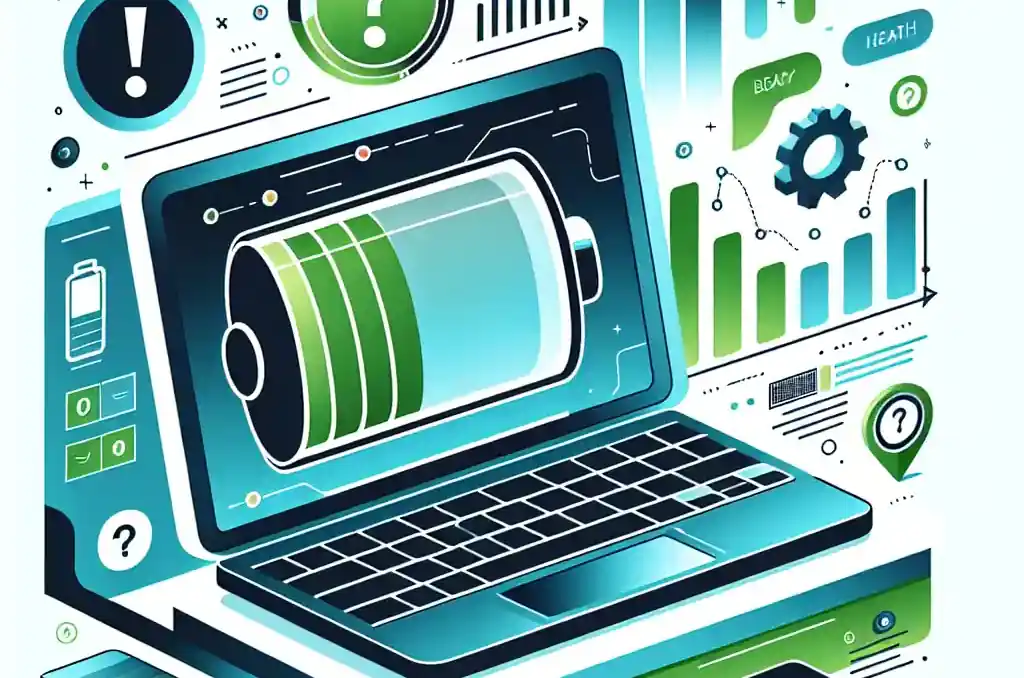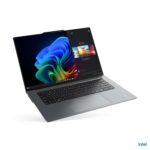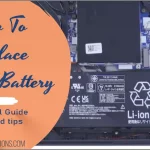This guide will walk you through how to check your laptop’s battery health in Windows, helping you troubleshoot issues and extend battery life.
Introduction
Keeping your laptop battery in good condition can mean the difference between seamless productivity and constant frustration. In this blog post, we will explore how to generate and interpret a battery report in Windows, identify common issues, and maintain your battery for long-term use.
- Introduction
- How To Generate a Battery Report in Windows 11
- Common Issues and Errors with the Battery Report
- How Batteries Degrade
- Windows Tools for Battery Health
- Third-Party Applications
- Best Practices for Battery Maintenance
- Troubleshooting Common Battery Issues
- FAQs
- Glossary of Technical Terms
- Battery Assessment Checklist
- Conclusion
How To Generate a Battery Report in Windows 11
Generating a battery report in Windows 11 is a straightforward process, and it can offer invaluable insights into your laptop’s battery health, capacity, and usage patterns. Follow these detailed steps to create and locate your battery report:
- Open Command Prompt as an administrator.
- Type `powercfg /batteryreport` and press Enter.
- The report will be saved in the specified location (usually in the Users folder).
- Open Command Prompt: First, you need to access the Command Prompt with administrative privileges. To do this, type “cmd” in the Windows search bar found on the taskbar, then right-click on the “Command Prompt” from the search results. Select “Run as administrator” from the context menu. A prompt will appear asking for permission; click “Yes” to proceed. Running the Command Prompt as an administrator is crucial; otherwise, the command may not execute properly.
- Generate the Report: With the Command Prompt open, you need to enter a specific command to generate your battery report. Type `powercfg /batteryreport` and press the Enter key. This command instructs Windows to compile a detailed report on your battery’s performance and status. Ensure that you type the command exactly as shown, with a space between “powercfg” and “/batteryreport.”
- Locate the Report: Once you execute the command, Windows will create and save the report. You will receive a confirmation message in the Command Prompt window stating the report location, usually in your user directory (e.g., `C:\Users\[YourUsername]\battery-report.html`). To easily access this report, open File Explorer and navigate to your user folder, or directly enter the path provided in the address bar of File Explorer.
By carefully following these steps, even those unfamiliar with system commands can successfully generate a comprehensive battery report
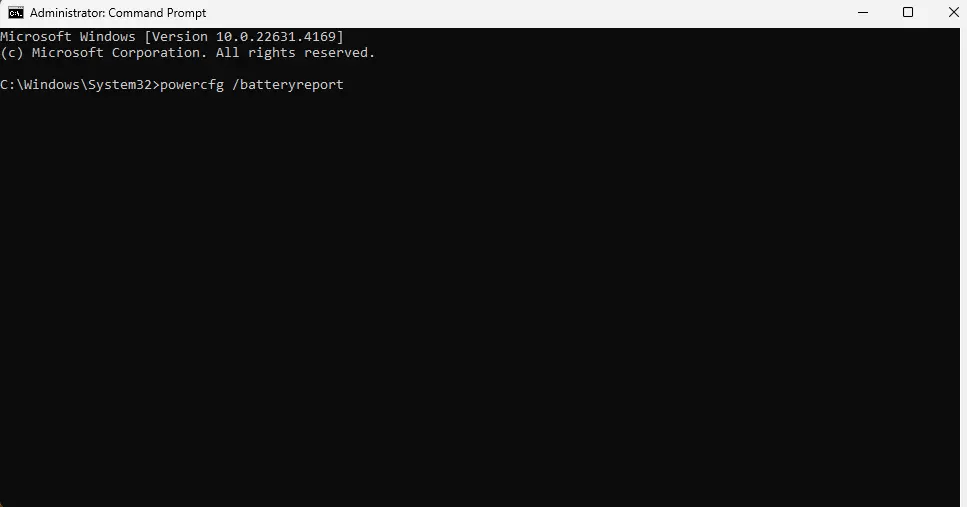
How to View the Battery Report
Once you’ve generated your battery report, it’s important to know how to access and interpret the data. Follow these detailed instructions to view your report:
- Locate the File: The battery report is saved as an HTML file in your user directory. To find this file, open File Explorer by either clicking on its icon in the taskbar or by pressing `Windows key + E` on your keyboard. Type or copy the file path you received (e.g., `C:\Users\[YourUsername]\battery-report.html`) directly into the address bar at the top of the File Explorer window, then press Enter.
- Open the Report: Once you’re at the correct location, look for the file named `battery-report.html`. Double-click on the file, and it should automatically open in your default web browser. This ensures you can easily view and navigate through the report thanks to the familiar web page format.
- Understanding the Sections: As you view the report, take note of several key sections:
- Battery Usage: This section provides detailed logs and graphs of your device’s power usage patterns.
- Usage History: View historical data showing full charge cycles and system power events.
- Battery Life Estimates: This offers projections on battery life based on past usage and current performance trends.
By following these steps, even those with limited technical experience can easily navigate to and open their battery report, gaining valuable insights into their device’s battery health and performance.
Lenovo Battery Not Charging? Do THIS
How to Check Laptop Battery Health
When viewing the battery report:
- Design Capacity vs. Full Charge Capacity:
Compare these two values to see how much your battery has degraded.
- Battery Usage:
Look for patterns in your charging habits.
- Battery Life Estimates:
This helps you understand your battery’s longevity based on current usage. The Secret to Long-Lasting Laptop Battery Life
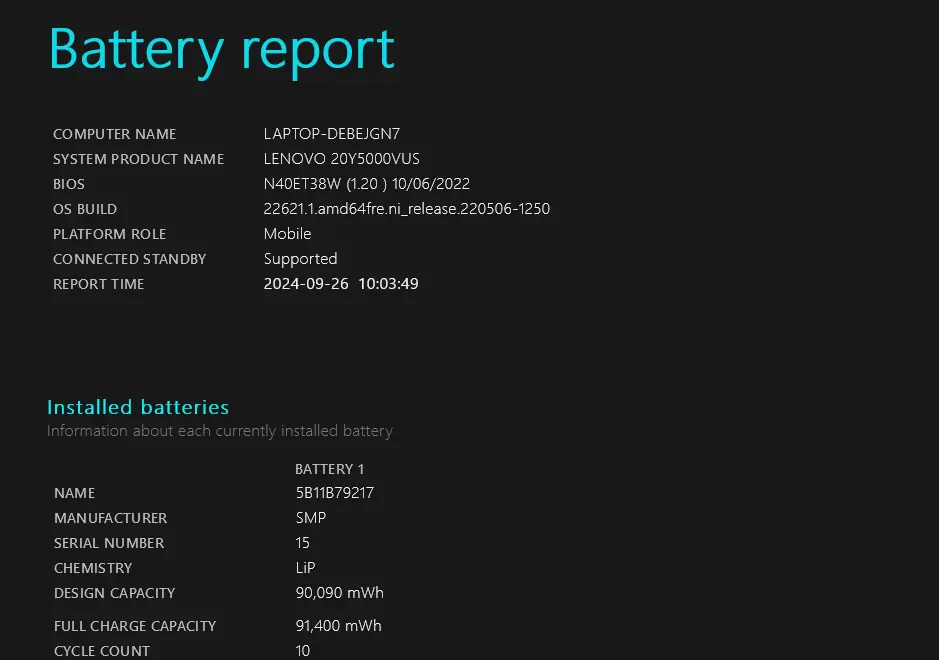
Common Issues and Errors with the Battery Report
Missing Data
If parts of your battery report are missing, it could be due to recent system updates or lack of usage data. Recheck after a few charge cycles.
Inconsistent Readings
Inconsistent readings might indicate a need for battery recalibration. Fully charge your laptop, discharge it completely, and then charge it to 100% again.
Software Glitches
Sometimes, software bugs can affect the battery report. Ensure your operating system is up-to-date.
How Batteries Degrade
Heat
Excessive heat is one of the primary factors that degrade battery health. Always ensure proper ventilation.
Usage Patterns
Frequent full discharges can wear down the battery faster. Aim for partial discharges when possible.
Age
All batteries degrade with age. A battery typically loses significant capacity after 2 to 3 years of use.
Windows Tools for Battery Health
Windows offers several built-in tools to help you monitor and manage battery health.
Powercfg Command
The `powercfg` command is versatile for generating detailed reports on battery performance and power settings.
Battery Saver Mode
Enable Battery Saver Mode to extend battery life during low-power situations by limiting background activity and reducing screen brightness.
Energy Report
Generate an energy report by typing `powercfg /energy` in Command Prompt. This report identifies inefficiencies and potential issues affecting battery life.
Third-Party Applications
In addition to Windows tools, third-party applications can provide more detailed insights into battery health.
BatteryInfoView
BatteryInfoView offers comprehensive data on battery status, including wear level and charge/discharge rates.
HWMonitor
HWMonitor tracks temperature, voltage, and more, giving you a real-time overview of your laptop’s hardware health.
BatteryCare
BatteryCare provides tips for optimizing battery usage and life span, alongside detailed stats on capacity and wear level.
Best Practices for Battery Maintenance
Maintaining your laptop battery involves adopting certain best practices.
Proper Charging Habits
Avoid keeping your laptop plugged in constantly. Charge it up to 80% and allow it to discharge to around 20%. The Risks Of Keeping Laptop Plugged In | Optimize Your Battery
Optimal Usage Settings
Adjust power settings to conserve battery life. Lower your screen brightness and turn off unnecessary features like Bluetooth and Wi-Fi when not in use.
Keeping It Cool
Heat is detrimental to battery life. Use cooling pads and ensure proper ventilation to keep your laptop cool.
Troubleshooting Common Battery Issues
Sudden Battery Drain
If your battery drains quickly, check for background applications consuming too much power. Use Task Manager to identify and close these apps.
Battery Not Charging
If your battery isn’t charging, try these steps:
- Check the AC adapter and power cable.
- Update your BIOS.
- Try a battery reset by holding the power button for 30 seconds with the battery removed.
Battery Not Detected
This could indicate a loose connection. Re-seat the battery and ensure it’s properly connected.
FAQs
How do I check if my laptop battery is bad?
Look for signs like rapid discharge, unexpected shutdowns, or swelling. Generate a battery report to check the design capacity versus the current full charge capacity.
Can I replace my laptop battery myself?
Yes, but it depends on your laptop model. Refer to your manufacturer’s guidance for battery replacement instructions. How to Replace Your Laptop Battery: A Step-by-Step Guide
Is it harmful to keep my laptop plugged in all the time?
Modern laptops manage charging efficiently, but it’s still best to unplug occasionally to prevent overheating and extend battery lifespan.
Glossary of Technical Terms
Command Prompt
Command Prompt is a command line interpreter application available in most Windows operating systems. It allows users to execute entered commands to perform advanced administrative functions or troubleshoot system issues. It essentially serves as a means to give direct instructions to the operating system, which offers more control over system functions than the graphical interface typically used in Windows. Users can perform tasks more efficiently by typing text commands instead of navigating with a mouse.
BIOS
BIOS, which stands for Basic Input/Output System, is a program pre-installed on Windows-based computers, which the computer uses to start up the operating system when it is turned on. It manages data flow between the computer’s operating system and attached devices such as the hard disk, video adapter, keyboard, mouse, and printer. BIOS is fundamental for booting up a computer and ensuring that the hardware components are working properly during startup before being utilized by the operating system.
Battery Assessment Checklist
Evaluate your current laptop battery practices using the checklist below to ensure optimal battery health and performance:
- Charging Habits
- Do you routinely charge your battery only up to 80%?
- Do you allow the battery to discharge to around 20% before recharging?
- Do you frequently let the battery discharge completely?
- Environment
- Is your laptop used in a well-ventilated area to prevent overheating?
- Do you use cooling pads to maintain a lower temperature?
- Power Settings
- Are your screen brightness settings adjusted for battery conservation?
- Are Bluetooth and Wi-Fi turned off when not in use?
- Have you enabled Battery Saver Mode when running low on power?
- Usage Patterns
- Are background applications monitored and managed to prevent excessive power usage?
- Do you close unnecessary apps using Task Manager to reduce battery drain?
- Software Management
- Is your operating system and BIOS regularly updated?
- Do you use third-party applications to gain insights into battery health?
- Maintenance Practices
- Have you installed any applications that offer tips for optimizing battery performance?
- Do you routinely check for loose connections if your battery isn’t detected?
- Have you attempted a battery recalibration if you notice inconsistent readings?
Review this checklist periodically to keep your laptop battery in excellent condition. Implement any changes necessary to promote enhanced battery longevity and reliability.
Conclusion
Regularly checking your laptop battery health is essential for maintaining optimal performance. By generating battery reports, addressing common issues, and following best practices for maintenance, you can ensure long-lasting productivity. Ready to take control of your laptop’s health? Start today by generating your first battery report and see where you stand.

J.S. is the owner, content creator, and editor at Upgrades-and-Options.com. I’ve worked in the IT and Computer Support field for over 20 years. The server hardware in my computer labs has mostly been IBM, but I’ve supported Dell, HP, and various other hardware. In addition, as part of my lab administrator responsibilities, I’ve learned, supported, and repaired/upgraded network hardware such as Cisco routers and switches. READ FULL BIO >>
- Upgrading SSD Storage in the ThinkPad X9-15 Gen 1 Aura EditionUpgrading SSD Storage and Analyzing Memory in the ThinkPad X9-15 Gen 1 Aura Edition Upgrade Your ThinkPad X9-15 SSD Like a Pro: A Technical Guide The ThinkPad X9-15 Gen 1 Aura Edition (Machine Types 21Q6 and 21Q7) is designed as a premium device. While memory is permanently fixed, users can easily expand storage capacity, as… Read more: Upgrading SSD Storage in the ThinkPad X9-15 Gen 1 Aura Edition
- How Quantum Computing Could Impact Everyday LaptopsQuantum computing may sound like science fiction, but its potential to revolutionize technology is very real. Unlike classical computing, which processes information using bits as 0s and 1s, quantum computing leverages the strange and exciting principles of quantum mechanics — like superposition and entanglement — to perform calculations at speeds previously thought impossible. This unprecedented… Read more: How Quantum Computing Could Impact Everyday Laptops
- What Is The Difference Between Lenovo’s Pens? (with Part Numbers)Do you ever find yourself writing with an old-school pen or even worse a pencil? As you pry your fingers off that last-century writing device, ask yourself if there isn’t a better way. Well ask no more, there is a whole world of digital pens out there just waiting for you to discover.I went through… Read more: What Is The Difference Between Lenovo’s Pens? (with Part Numbers)
- Legion 5 Laptop Upgrade Guide: Game Like a ProThis article serves as your ultimate guide to upgrading your Lenovo Legion 5 laptop with RAM and SSD, unlocking its potential to deliver unbeatable gaming performance. With over two decades of expertise in the tech industry and countless successful upgrade projects under my belt, I’ve distilled all my knowledge into this comprehensive guide. You’ll learn,… Read more: Legion 5 Laptop Upgrade Guide: Game Like a Pro
- How to Replace Your Laptop Battery: A Step-by-Step GuideLaptop battery not lasting as long? Replacement may be needed. Before we jump into the process, it is essential to mention that you will require some tools. You’ll need a screwdriver (or two), a new laptop battery (make sure you get the right one), and a clean workspace. THIS POST MAY CONTAIN AFFILIATE LINKS. As… Read more: How to Replace Your Laptop Battery: A Step-by-Step Guide

